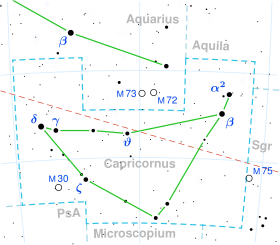
Summary
Psi Capricorni, Latinized from ψ Capricorni, is a single[10] star in the southern zodiac constellation of Capricornus. It is a yellow-white hued star that is faintly visible to the naked eye with an apparent visual magnitude of +4.13.[2] The distance to this star is approximately 47.9 light years based on parallax measurements,[1] and it is drifting further away with a radial velocity of +20 km/s.[4] The closest approach to the Sun occurred some 467,000 years ago at a separation of 20 light-years.[11]
| Observation data Epoch J2000 Equinox J2000 | |
|---|---|
| Constellation | Capricornus |
| Right ascension | 20h 46m 05.73263s[1] |
| Declination | −25° 16′ 15.2312″[1] |
| Apparent magnitude (V) | 4.13[2] |
| Characteristics | |
| Spectral type | F5 V[3] |
| U−B color index | −0.03[2] |
| B−V color index | +0.42[2] |
| Astrometry | |
| Radial velocity (Rv) | +20.3[4] km/s |
| Proper motion (μ) | RA: −51.96[1] mas/yr Dec.: −156.56[1] mas/yr |
| Parallax (π) | 68.13 ± 0.27 mas[1] |
| Distance | 47.9 ± 0.2 ly (14.68 ± 0.06 pc) |
| Absolute magnitude (MV) | 3.33[5] |
| Details | |
| Mass | 1.37[6] M☉ |
| Radius | 1.51+0.08 −0.04[7] R☉ |
| Luminosity | 3.82±0.03[7] L☉ |
| Surface gravity (log g) | 4.25[6] cgs |
| Temperature | 6,572+89 −173[7] K |
| Metallicity [Fe/H] | 0.15[6] dex |
| Rotational velocity (v sin i) | 40.9±2.0[8] km/s |
| Age | 1.4[3] Gyr |
| Other designations | |
| Database references | |
| SIMBAD | data |
This object is an F-type main-sequence star with a stellar classification of F5 V/[3] It is 1.4[3] billion years old with 1.4[6] times the mass of the Sun. The measured rotational velocity of this star is approximately 41 km/s[8] (the Sun has an equatorial rotation velocity of 2 km/s). Analysis of the line profile of the star's spectrum indicates that it is undergoing differential rotation, with the variation by latitude being similar to the Sun.[12] The star has 1.5[7] times the Sun's radius and is radiating 3.8[7] times the luminosity of the Sun from its photosphere at an effective temperature of 6,572 K.[7] It displays an infrared excess, suggesting the presence of an orbiting debris disk at a separation of 38.75 AU and a temperature of 60 K.[13]
Chinese name edit
In Chinese, 天田 (Tiān Tián), meaning Celestial Farmland, refers to an asterism consisting of ψ Capricorni, ω Capricorni, 3 Piscis Austrini, and 24 Capricorni.[14] Consequently, the Chinese name for ω Capricorni itself is 天田四 (Tiān Tián sì, English: the Fourth Star of Celestial Farmland).[15]
In R. H. Allen's version, this star represented the battle-axe Yue.[16]
References edit
- ^ a b c d e f van Leeuwen, F. (November 2007), "Validation of the new Hipparcos reduction", Astronomy and Astrophysics, 474 (2): 653–664, arXiv:0708.1752, Bibcode:2007A&A...474..653V, doi:10.1051/0004-6361:20078357, S2CID 18759600.
- ^ a b c d Mermilliod, J.-C. (1986), "Compilation of Eggen's UBV data, transformed to UBV (unpublished)", Catalogue of Eggen's UBV Data, SIMBAD, Bibcode:1986EgUBV........0M.
- ^ a b c d Ehrenreich, D.; et al. (November 2010), "Deep infrared imaging of close companions to austral A- and F-type stars", Astronomy and Astrophysics, 523: A73, arXiv:1007.0002, Bibcode:2010A&A...523A..73E, doi:10.1051/0004-6361/201014763, S2CID 54913363.
- ^ a b Nordström, B.; et al. (2004), "The Geneva-Copenhagen survey of the Solar neighbourhood. Ages, metallicities, and kinematic properties of ~14000 F and G dwarfs", Publications of the Astronomical Society of Australia, 21 (2): 129–133, arXiv:0811.3982, Bibcode:2004PASA...21..129N, doi:10.1071/AS04013, S2CID 123457673.
- ^ Reiners, Ansgar (January 2006), "Rotation- and temperature-dependence of stellar latitudinal differential rotation", Astronomy and Astrophysics, 446 (1): 267–277, arXiv:astro-ph/0509399, Bibcode:2006A&A...446..267R, doi:10.1051/0004-6361:20053911, S2CID 8642707
- ^ a b c d Luck, R. Earle (March 2018), "Abundances in the Local Region. III. Southern F, G, and K Dwarfs", The Astronomical Journal, 155 (3): 31, Bibcode:2018AJ....155..111L, doi:10.3847/1538-3881/aaa9b5, S2CID 125765376, 111.
- ^ a b c d e f Brown, A. G. A.; et al. (Gaia collaboration) (August 2018). "Gaia Data Release 2: Summary of the contents and survey properties". Astronomy & Astrophysics. 616. A1. arXiv:1804.09365. Bibcode:2018A&A...616A...1G. doi:10.1051/0004-6361/201833051. Gaia DR2 record for this source at VizieR.
- ^ a b Ammler-von Eiff, Matthias; Reiners, Ansgar (June 2012), "New measurements of rotation and differential rotation in A-F stars: are there two populations of differentially rotating stars?", Astronomy & Astrophysics, 542: A116, arXiv:1204.2459, Bibcode:2012A&A...542A.116A, doi:10.1051/0004-6361/201118724, S2CID 53666672.
- ^ "psi Cap". SIMBAD. Centre de données astronomiques de Strasbourg. Retrieved 2019-10-24.
- ^ Eggleton, P. P.; Tokovinin, A. A. (September 2008), "A catalogue of multiplicity among bright stellar systems", Monthly Notices of the Royal Astronomical Society, 389 (2): 869–879, arXiv:0806.2878, Bibcode:2008MNRAS.389..869E, doi:10.1111/j.1365-2966.2008.13596.x, S2CID 14878976.
- ^ Bailer-Jones, C. A. L. (March 2015), "Close encounters of the stellar kind", Astronomy & Astrophysics, 575: 13, arXiv:1412.3648, Bibcode:2015A&A...575A..35B, doi:10.1051/0004-6361/201425221, S2CID 59039482, A35.
- ^ Reiners, Ansgar; Schmitt, Jürgen H. M. M.; Kürster, Martin (September 2001), "Detection of differential rotation in psi Cap with profile analysis", Astronomy and Astrophysics, 376: L13–L16, arXiv:astro-ph/0107332, Bibcode:2001A&A...376L..13R, doi:10.1051/0004-6361:20011023, S2CID 14762283.
- ^ Gáspár, András; et al. (2016), "The Correlation between Metallicity and Debris Disk Mass", The Astrophysical Journal, 826 (2): 171, arXiv:1604.07403, Bibcode:2016ApJ...826..171G, doi:10.3847/0004-637X/826/2/171, S2CID 119241004.
- ^ (in Chinese) 中國星座神話, written by 陳久金. Published by 台灣書房出版有限公司, 2005, ISBN 978-986-7332-25-7.
- ^ (in Chinese) AEEA (Activities of Exhibition and Education in Astronomy) 天文教育資訊網 2006 年 7 月 3 日
- ^ Allen, R. H. (1963), Star Names, Dover, p. 142
External links edit
- Kaler, James (September 25, 2009), "Psi Capricorni", STARS, retrieved 2019-10-25.
- "4C01688". ARICNS. 1998-03-04. Archived from the original on 2011-06-07. Retrieved 2006-08-16.



